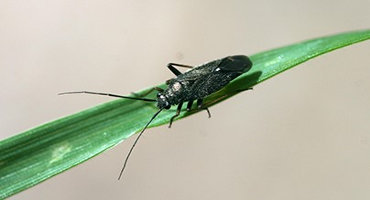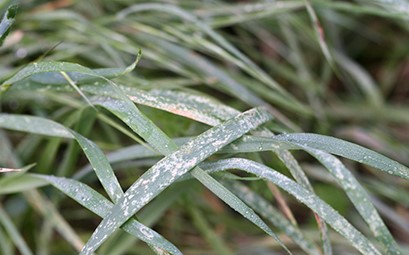By Patrick Wagner
This month, we received reports of high numbers of black grass bugs showing up in parts of Southwestern South Dakota. However, the bugs were mostly isolated to grassy areas dominated by crested wheatgrass. This is expected, as black grass bugs typically prefer wheatgrasses over other types of grass. The drought conditions experienced throughout South Dakota in recent years have forced many farmers and ranchers to rest some of their pastures. The reduced grazing and haying activity has allowed black grass bug populations to steadily increase during this time. Large populations of black grass bugs can cause considerable damage (up to 90% forage reduction) to pasture and range, making it important to be aware and monitor their populations each spring.
Profile
Black grass bugs (Figure 1) are native to South Dakota and the Great Plains region. They are approximately ¼ inch long with most species being uniformly black in color. Black grass bugs overwinter as eggs and hatch out in April and May. Upon hatching, the nymphs immediately begin feeding on the tender new grass and mature over the next 4 to 5 weeks. Once they become adults, they live for several more weeks to mate and lay eggs. Black grass bugs are only active in the spring, having just one generation per year.

Figure 1. Black grass bug adult. Courtesy: Whitney Cranshaw, Colorado State University
Feeding Injury
Injury from the black grass bug appears as light-colored spots on the leaves (Figure 2). This type of injury is called stippling, which reduces forage quality and can deter livestock grazing. Areas of grassland with severe infestations may appear yellowish brown or white. Black grass bugs primarily feed on grasses, but can also feed on broadleaf plants as well. They prefer wheatgrasses including crested and intermediate. This makes pastures that are composed of wheatgrass monocultures the most susceptible to infestation. Severe infestations may cause black grass bugs to move into nearby fields of small grains, although injury is usually minimal and limited to the field edges.

Figure 2. Feeding injury caused by black grass bugs. Courtesy: Whitney Cranshaw, Colorado State University
Management
Currently, there are no established thresholds for managing black grass bugs. However, early detection is recommended because these insects can quickly cause widespread damage. Check grasslands for areas of discoloration, and inspect plants for stippling damage or the presence of black grass bugs. A sweep net may be helpful when scouting, as the bugs usually drop to the ground when disturbed.
Click here to see more...